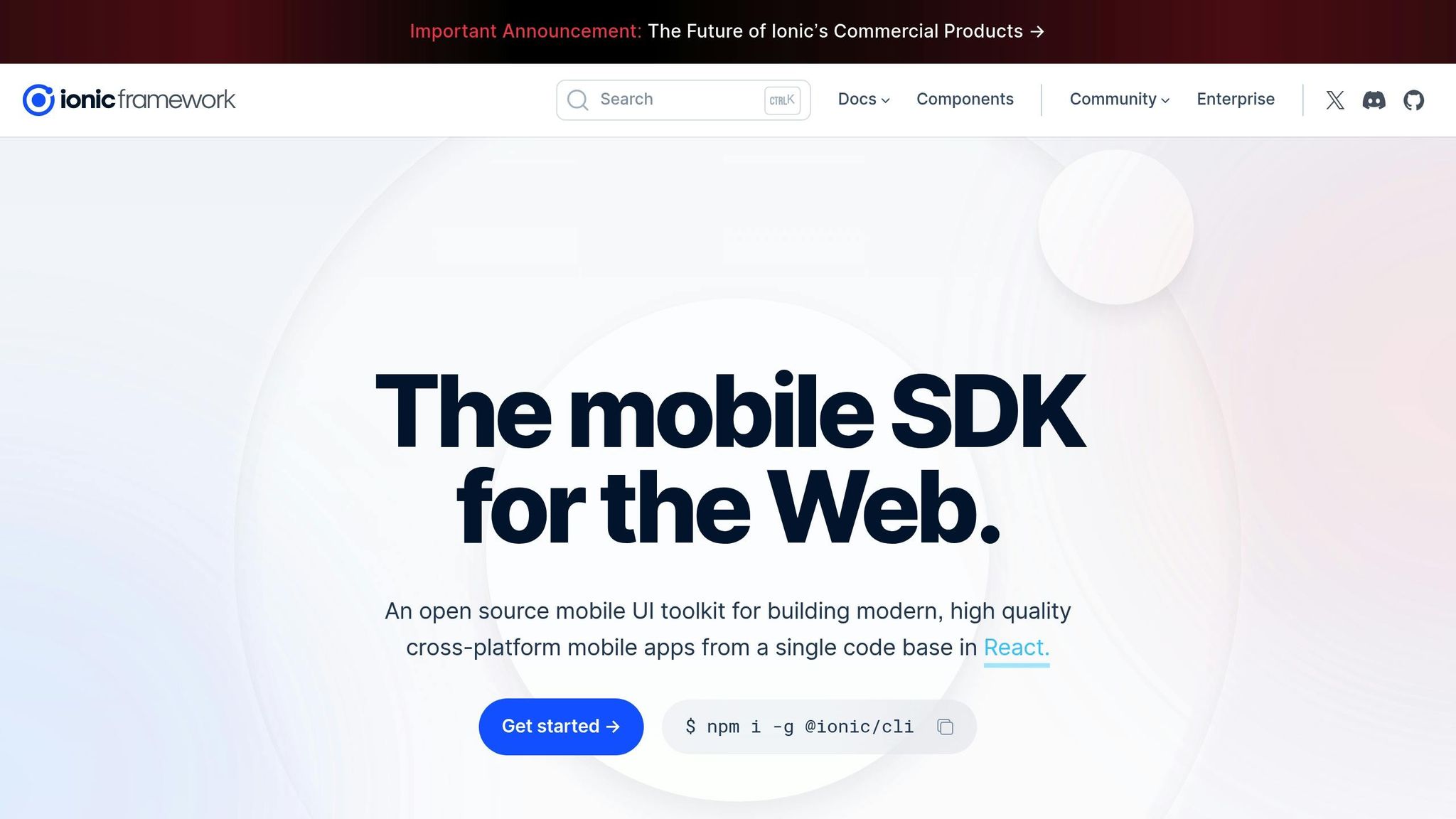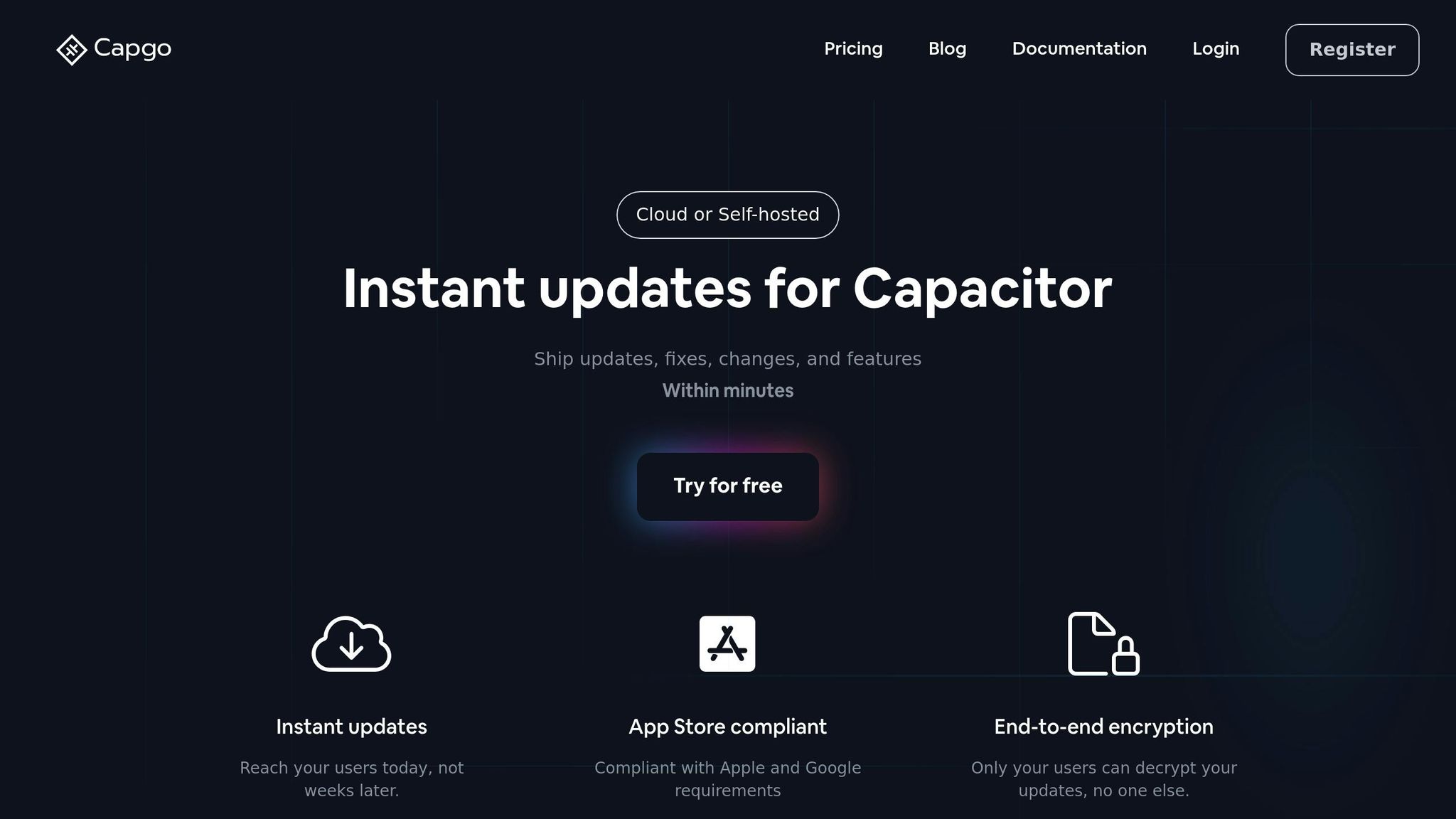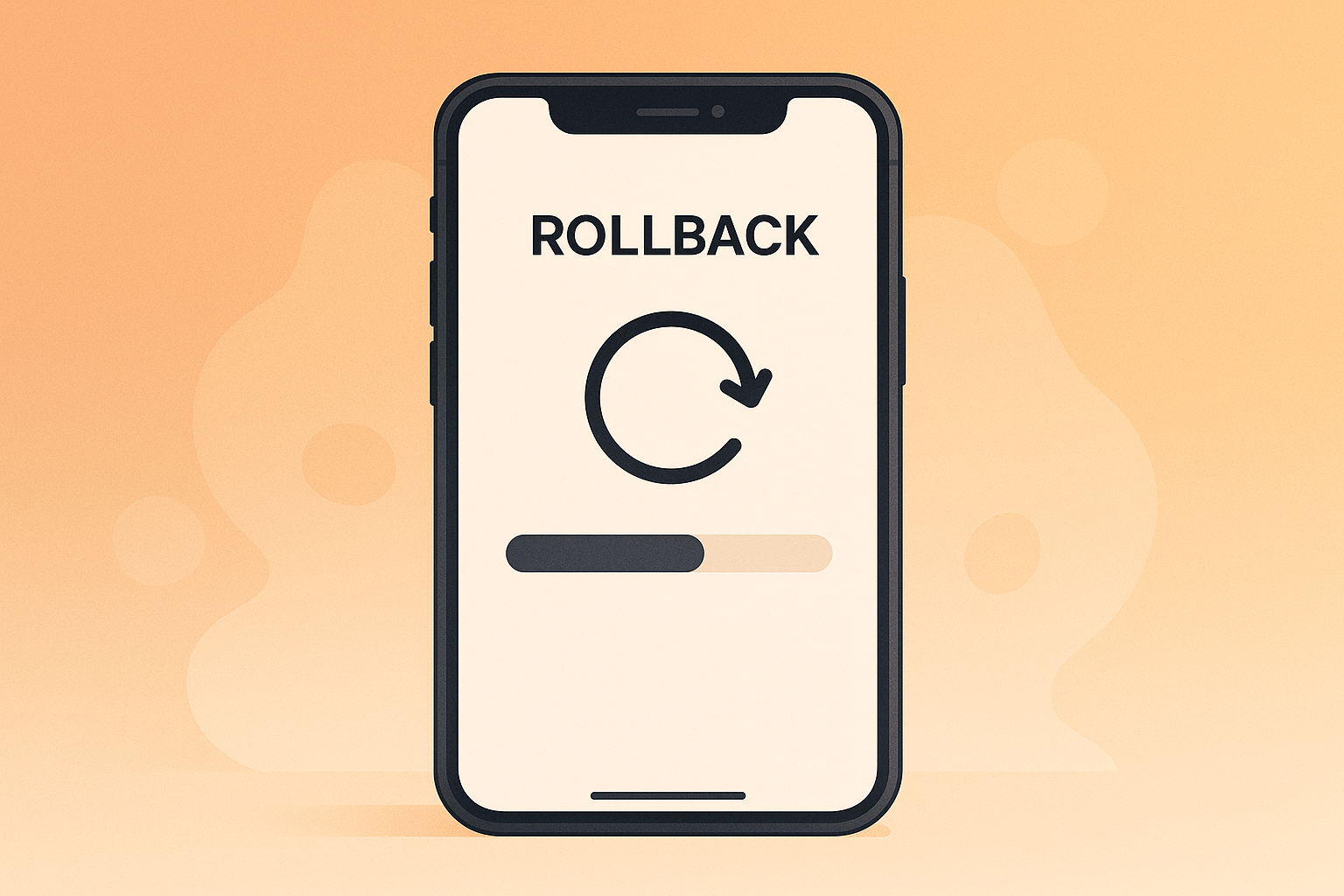Avoid app disruptions with strong rollback strategies. Capacitor’s live updates let you deliver fixes quickly, but 18% of updates fail globally. A rollback plan ensures stability when issues arise. Here’s a quick overview:
- Key Tools: Version control, error tracking, analytics, and one-click rollback.
- When to Roll Back: Severe slowdowns, broken features, security risks, or data issues.
- Steps to Prepare:
- Use beta testing to catch problems early.
- Set up monitoring for real-time error alerts.
- Define rollback triggers and response protocols.
Platforms like Capgo offer fast updates (114ms for 5MB), high success rates (82%), and cost-effective solutions (from $12/month). They also support rollback automation, real-time tracking, and user segmentation, making them a reliable choice for managing live updates.
| Feature | Capgo | Appflow | | --- | --- | --- | --- | | Update Speed | 114ms | Standard | Standard | | Success Rate | 82% | Not Published | Not Published | | End-to-End Encryption | Yes | No | No | | Self-Hosting Option | Yes | No | No | | Monthly Cost | From $12 | Similar | ~$500 |
Set up rollback tools today to ensure smooth updates and maintain user trust.
How to Migrate Your Ionic App to Capacitor 3

Building Strong Rollback Strategies
A solid rollback strategy ensures your app stays stable during live updates and allows for quick recovery if something goes wrong. Let’s break down the key components and steps needed to make rollbacks seamless.
Key Rollback Components
For rollbacks to work effectively, certain tools and systems need to be in place to recover to a stable version without hassle.
| Component | Purpose | Implementation |
|---|---|---|
| Version Control | Quickly revert to previous versions | Keep detailed version histories with metadata |
| Error Tracking | Decide when to roll back | Use real-time issue detection and alerts |
| Analytics System | Assess the need for rollback | Monitor metrics showing deployment impact |
| Channel Management | Manage update distribution | Separate environments for production and testing |
| One-Click Rollback | Allow fast recovery | Enable instant reversion to the last stable version |
When to Trigger a Rollback
Real-time error tracking helps determine when rolling back is necessary. Here are the most common situations where this might be required:
- Critical Performance Issues: Severe slowdowns that affect app usability.
- Feature Malfunctions: Failures in core functionalities that users rely on.
- Security Vulnerabilities: Newly discovered risks that need immediate attention.
- Data Integration Problems: Backend connectivity issues disrupting app operations.
Getting Ready for Rollbacks
Preparation is key to making rollbacks smooth and effective. Here’s how to set up for success:
-
Beta Testing Channel
Release updates to a small group of users first to identify potential issues early. -
Monitoring Setup
Track success rates, engagement, errors, and performance metrics to spot problems quickly. -
Rollback System Configuration
- Keep a detailed version history.
- Set up automated alerts for issues.
- Define clear rollback triggers.
- Establish response protocols to act quickly.
Setting Up Rollbacks in Capacitor
Update Channels Setup
To minimize user impact and isolate potential issues, it’s important to configure update channels effectively.
- Testing Channel: Create a dedicated channel for beta testing with a smaller group of users. This helps identify problems before a wider rollout.
- Production Channel: Use this channel for stable releases intended for your entire user base.
- Version Controls: Set clear version tracking parameters for each channel to maintain organization and control.
Capgo’s channel system makes it easy to test pull requests directly within the app. This reduces the chances of problematic updates making it to production.
Automated Rollback Systems
Automated rollbacks ensure that updates don’t cause prolonged issues. Here’s a breakdown of key components:
| Component | Purpose | Implementation Tips |
|---|---|---|
| Version Control | Track deployment history | Monitor progress and outcomes consistently |
| Error Thresholds | Define rollback triggers | Use specific metrics to automate rollbacks |
| Response Protocol | Outline recovery steps | Set up workflows for immediate issue handling |
For example, when colenso adopted Capgo’s OTA updates for their 5,000+ users, they were able to distribute updates almost instantly and with minimal disruptions. This success was largely due to automated rollback safeguards [1].
With these automated systems, continuous monitoring is essential to catch and address issues early.
Rollback Monitoring
Even with automated triggers, monitoring plays a critical role in ensuring smooth recovery from any issues.
Real-Time Analytics: Use analytics tools to track update success rates and user engagement. Capgo’s system provides instant insights into update performance, helping developers identify problems before they escalate.
Error Tracking: Set up a robust error monitoring system with alerts for:
- Major performance drops
- Broken features
- Connectivity problems
- Security vulnerabilities
Your monitoring setup should include one-click rollback functionality. This allows you to quickly revert to a stable version if needed. Since Microsoft’s Code Push shutdown in 2024, many developers have turned to alternatives like Capgo for reliable live update management.
Rollback Tools Comparison
Rollback Platform Features
Since Microsoft CodePush shut down in 2024, the options for managing live updates in Capacitor apps have expanded. Today’s platforms offer various tools to handle updates and rollbacks effectively. Here’s how Capgo stacks up against competitors:
| Feature | Capgo | Appflow | | --- | --- | --- | --- | | Update Speed | 114ms (5MB bundle) | Standard | Standard | | Success Rate | 82% worldwide | Not published | Not published | | End-to-End Encryption | Yes | No | No | | Self-hosting Option | Yes | No | No | | CI/CD Integration | Built-in | Limited | Yes | | Monthly Cost | From $12 | Similar | ~$500 |
These features highlight Capgo’s ability to deliver fast updates, strong security, and cost-effective solutions.
Capgo Rollback Features

Capgo has powered 1.4K active apps and delivered over 947.6M updates globally [1]. Its rollback capabilities include:
- One-click rollback: Quickly revert to a previous version if needed.
- Real-time update tracking: Monitor updates as they happen.
- User segmentation: Roll out updates to specific user groups.
- Global CDN distribution: Ensure updates are delivered efficiently worldwide.
This proven track record makes Capgo a dependable choice for managing updates in production environments.
Open-Source Benefits
Capgo’s open-source framework offers key advantages for developers in the U.S. It guarantees full code transparency, encourages community-driven security enhancements, and ensures compliance with Apple and Android app store requirements. These factors make it a trusted option for teams needing reliable update tools.
“Cancelled my @Appflow subscription after 4 years. Code-Push never seemed to work well, hopefully @CapGO has it figured out.” [1]
Rollback Success Tips
When implementing rollbacks, it’s crucial to focus on minimizing disruptions for users and ensuring data remains secure throughout the process.
Reducing User Impact
To avoid widespread disruptions, start by deploying updates to a small group of users. Tools like Capgo allow you to assign updates to specific user groups, making it easier to manage the rollout. Begin with a small percentage (5–10%) of users, monitor performance indicators, and only expand the rollout once the update proves stable.
Data Protection During Rollbacks
Data security is a top priority during rollbacks. Capgo uses end-to-end encryption, ensuring that only authorized users can access updates, which helps maintain data integrity during version transitions [1]. Sensitive user information is safeguarded throughout the process.
| Security Measure | Purpose | Benefit |
|---|---|---|
| End-to-End Encryption | Protect update delivery | Blocks unauthorized access |
| Version Control | Ensure data consistency | Smooth transitions between versions |
| Error Tracking | Detect potential issues | Supports a global success rate of 82% [1] |
Measuring Rollback Results
To evaluate rollback performance, track metrics like update success rates, user engagement, and error frequency. Capgo’s analytics dashboard provides these insights, enabling teams to make informed decisions about rollback strategies and future updates. The platform’s error tracking ensures issues are identified and resolved quickly. Regularly refining your metrics will help maintain app stability with every update.
Conclusion
Main Points Review
Rollback strategies play a key role in maintaining app stability and ensuring user confidence. Metrics consistently show how these strategies support a structured approach to managing updates effectively.
Here’s a breakdown of the essential components for a smooth rollback process:
| Component | Purpose | Impact |
|---|---|---|
| One-Click Rollback | Quickly revert to a previous version | Reduces downtime |
| Channel System | Deploy updates in stages | Lowers risk exposure |
| Error Tracking | Monitor issues in real-time | Supports faster fixes |
These features are central to any rollback plan, making it easier to implement changes while minimizing disruptions.
Getting Started
To put these strategies into action, follow these steps:
- Install deployment tools using
npx @capgo/cli init. - Configure update channels for beta and production environments.
- Set up monitoring to track success rates and user engagement.
Capgo’s automated rollback system proves its effectiveness, with 1.4K production apps and 947.6M updates delivered [1]. The platform has shown it can handle large-scale deployments seamlessly.
“Capgo is a must have tools for developers, who want to be more productive. Avoiding review for bugfix is golden.” - Bessie Cooper [1]
FAQs
::: faq
What are the essential steps for creating a reliable rollback strategy for live updates in Capacitor apps?
An effective rollback strategy for live updates in Capacitor apps involves careful planning and execution to ensure app stability and a smooth user experience. Key components include:
- Version Control: Maintain a clear versioning system for updates to easily identify and revert problematic changes.
- Testing and Monitoring: Thoroughly test updates before release and monitor app performance post-deployment to detect issues quickly.
- Rollback Mechanism: Implement a rollback process that allows you to revert to a previous stable version seamlessly if an update causes issues.
Using tools like Capgo can simplify this process by offering real-time updates, user-specific assignments, and compliance with Apple and Android standards, ensuring a streamlined and secure update management system. :::
::: faq
How do automated rollback systems reduce disruptions during app updates?
Automated rollback systems help reduce disruptions during app updates by allowing developers to quickly switch back to a stable version if an update causes issues. This ensures users can continue using the app with minimal interruptions, maintaining a smooth experience.
These systems are especially valuable for live updates in Capacitor apps, as they provide a safety net for addressing unexpected problems without requiring time-consuming manual intervention or app store resubmissions. By automating rollbacks, developers can focus on resolving issues while minimizing the impact on users. :::
::: faq
Why should I use a testing channel before rolling out updates to all users?
Using a testing channel before deploying updates to your entire user base is crucial for ensuring a smooth user experience. It allows you to identify and fix potential bugs, compatibility issues, or performance problems in a controlled environment, minimizing the risk of widespread disruptions.
By testing updates with a smaller group of users first, you can gather valuable feedback, monitor performance metrics, and make necessary adjustments before a full-scale release. This approach not only improves the quality of your updates but also helps maintain user trust and satisfaction. :::




